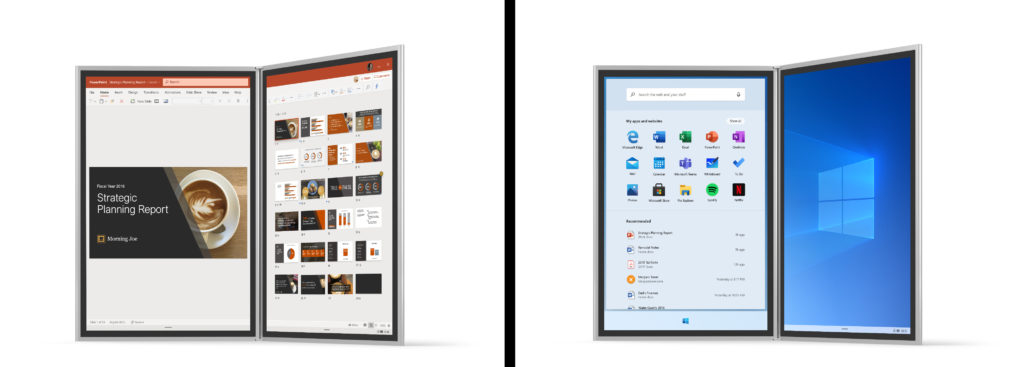
Microsoft has (partially) unveiled a unique twist on its operating system that it has dubbed Windows 10X – designed to run on dual-screen devices.
Potentially confusingly, it appears that this won’t be used on the new Android-powered Microsoft Surface Duo – a twin-screen smartphone the company unveiled today, which that features two 5.6-inch screens
(Bloomberg has a good take on that and Microsoft’s unexpected dive back into the smartphone market – a move that’s drawn mixed reactions.)
#Surface Duo is the first Surface that fits in your pocket! Two 5.6” screens that unfold to 8.3”.
Surface Duo brings together the best of Microsoft productivity, Android apps and Surface hardware design into a device you can take anywhere. Coming Holiday 2020. #MicrosoftEvent pic.twitter.com/eSs1cZrSV9— Yusuf Mehdi (@yusuf_i_mehdi) October 2, 2019
Instead, Windows 10X – set to land in 2020 – will run on Microsoft Surface laptops and devices from OEM partners ASUS, Dell, HP and Lenovo.
“The first wave of devices will vary in size, design and specs, and be powered by Intel”, Microsoft said, in a consumer-focussed blog on the OS.
Windows 10X appears to be a twist on Windows 10 that features “newly implemented support for running Win32 applications in a container”. (Win32 is the main set of Microsoft Windows APIs used for developing 32-bit applications).
The company is being somewhat coy with details, but what it is revealed suggests/reflects some significant ongoing architectural changes to how Windows runs.
Just What Is Windows 10X? Front-End…
Microsoft describes Windows 10X as “the best of Windows 10 built to enable unique experiences on multi-posture dual-screen PCs.”
From an end-user perspective, Redmond says it wants to create an OS that lets users take notes on one screen while “reviewing a full project proposal on the other while in transit; sit down at a table to write a thoughtful email on a hardware keyboard while waiting for lunch; and then watch a video, browse the web or read a book.”
The company adds: “For our commercial customers, we think this experience appeals to mobile professionals who want a device that can keep up when they’re on the go.”
… and Under the Hood
The OS variant is built around Microsoft’s “OneCore” modular approach to building everything from desktop PCs, to Xbox consoles and HoloLens headsets. (Its OneCore includes the kernel, networking, power management, authentication, cryptography, device management, storage, among other components.)
Eran Megiddo, Microsoft’s corporate VP, Windows and education, says: “Windows 10X is… built on the latest investments in these [its ‘One Core’] shared technologies.
He added: “This, together with further componentization and additional investments, gives us the power to deliver more flexible experiences with a wide range of input types and hardware postures all while managing Windows applications.”
“Advancements in the Core Technology of Windows”
Megiddo notes: “Windows 10X also includes some advancements in the core technology of Windows that optimize it for flexible postures and more mobile use.
“We needed to deliver battery life that could drive not just one, but two screens. We wanted the operating system to be able to manage the battery effect of our huge catalog of Windows apps, whether they were written in the last month or five years ago.”
The company appears reluctant to reveal too much more about how Windows 10X differs from Windows 10 at this point at the architectural level, but says it will be “engaging with our app developer ecosystem as Windows 10X presents unique opportunities for them to enrich their experiences with dual-screen PCs.”
More details have been promised “in coming months”.
Analyst reaction
Geoff Blaber, VP Research, CCS Insight said: ““Attention will fixate on Microsoft’s use of Android and its return to the smartphone market but this misses the bigger picture.
“This is a bold expansion of the Surface portfolio designed to show Windows manufacturers the ‘art of the possible’ in new categories and ensure Microsoft is controlling its own destiny with Surface hardware”
“Broadening its silicon partners to include AMD and Qualcomm will inevitably raise eyebrows and cause Intel to look over its shoulder. The reality is that this is about choice, control and flexibility as Microsoft widens the Surface portfolio to address a growing range of devices and use cases”
“With Surface Neo and Duo, Microsoft is taking a brave step into a very new category. Whilst Microsoft will avoid some of the issues that characterize flexible displays, the dual-screen approach is similarly new and will require developer support to fully realize the vision and take the concept beyond a commercial experiment”
“The launch of Surface Duo will inevitably draw comparison with its doomed Windows Phone investments. Duo is not without risk but Microsoft isn’t trying to repeat history and reinvent the wheel. It’s using an established platform to deliver a new category that is optimized for a Microsoft experience”
“Surface Duo is a bold new category of device and will take time to build developer and carrier support. This is the start of a journey for Microsoft and expectations should be set accordingly”






